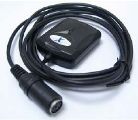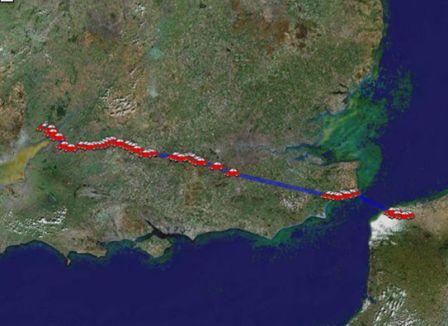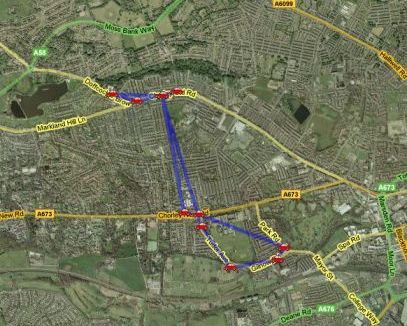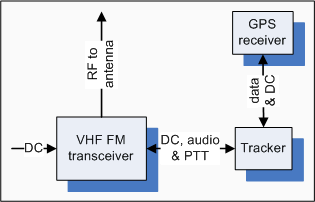APRS mobile tracking
The Kenwood TM-D700 mobile and TH-D7 handie radios have built-in TNC and APRS functions: all that is required is an external source of GPS data. However, you don't need anything so sophisticated (or expensive) to enjoy the benifits of APRS mobile tracking.
When I started operating an APRS Tracker in my car, I used a Garmin eTrex handheld GPS receiver on the dashboard to provide the position information, but I've now found an inexpensive and unobtrusive alternative which can be left in the car while I take the eTrex out hiking.
GPS receiver
 There are a number of simple GPS receivers on the market for around £30, which provide the required output for the tracker. A dozen GMR members have used the N103 receiver, but sadly these are no longer available.
There are a number of simple GPS receivers on the market for around £30, which provide the required output for the tracker. A dozen GMR members have used the N103 receiver, but sadly these are no longer available.
The current alternatives are:
Polstar receiver (pin-outs here and now tried and tested with an OpenTrackerPlus)
Note that the above unit uses a 6-pin mini-DIN connector, so you'll need to make a patch-lead).
This list is by no means comprehensive, but the chosen unit must have NMEA RS-232 serial output at 4800 baud to work with the present Tracker units described below.
These units have neither display nor user-interface, but are designed to connect to a PC or PDA, which runs navigation software. Most of them have a similar 6-pin mini-DIN interface, to connect the serial data and power supply (typically 5 volts at a few tens of milliamps), so it's just necessary to modify or make up a patch-lead to connect to the 9-way D-type RS-232 port on the Tracker.
The latest Tracker models include a regulated 5V ouput to supply power to the external GPS receiver too.
Tests with the N103 model have shown that it's sensitive enough to operate reliably when installed underneath the parcel-shelf in the rear of a hatchback (thus out of sight from outside the vehicle).
We've recently discovered that some of the "road safety warning" GPS units, such as the Talex, will produce the NMEA serial data, but this may only be available at 9600 baud. In this case, a TNC with APRS capability, or even the new Tracker2 from Argent Data Systems can be set to accept this rate and generate the mobile APRS beacons.
G8HIK-9 uses his Talex with a Tiny-2 mk2 TNC.
Here are a couple of examples of my recent tracks:


Tracker
There are two US-based companies providing low-cost ($30 to $45) Tracker hardware: Argent Data Systems
and Byonics.
The Byonics Trackers are now available direct from
a UK dealer.
The units may be purchased either fully-assembled or in kit form, and miniature surface-mount versions (to fit inside a radio or microphone) are also available.
In both cases, the Tracker must first be connected to a PC, to set up the configuration of station ID and other parameters (download my new Tracker Quick-Start Guide).
Once set, the Tracker remembers its settings, and is ready to be powered up whenever needed.
The simple Trackers are basically a transmit-only devices, but do include a simple noise-detector on the receiver output, to prevent it from transmitting when the channel is in use.
The newer Trackers (OpenTracker OT1+ and Tracker2) can also decode incoming packets, and output waypoints to a connected GPS receiver, or even operate as a TNC.
For more information on the Tracker2, see
this page.
It's also worth noting that newer (1997 or later) TNC (Terminal Node Controller) units, such as the PacComm Tiny-2 Mk2 can be set to read the NMEA serial data from a GPS receiver and so act as a Tracker too. These can be picked up second-hand for under £50.
Transceiver
 All that's needed is an FM transceiver which can tune to 144.8MHz. I use a single-channel converted ex-PMR set, but any mobile or portable FM set may be used. No modifications should be needed to transmit the 1200 baud AFSK tones through the existing microphone circuitry.
All that's needed is an FM transceiver which can tune to 144.8MHz. I use a single-channel converted ex-PMR set, but any mobile or portable FM set may be used. No modifications should be needed to transmit the 1200 baud AFSK tones through the existing microphone circuitry.
The receiver is only needed to check for channel occupancy, so even if the loudspeaker output is distorted, the set may still be useful in this application.
If the transceiver can provide a DC supply of 8-12V on one of the microphone socket pins, this can be used to power up the Tracker (which in turn provides the power for the GPS) and will simplfy the inter-connections to a single lead. It also means that the whole system can be powered up or down by simply switching power to the transceiver.
Antenna
A simple quarter-wave should be adequate to get your transmissions to the nearest RELAY or IGate. If you're aiming for a low-visiblity system, consider a "micro-mag-mount", an "on-glass" mount, or even sticking the radiating elements on the inside of the windscreen.
Right, I'm ready to go! You can see where I've been recently by looking at the
DB0ANF site. This reports my most recent positions relayed via an internet gateway.
Happy tracking!
 There are a number of simple GPS receivers on the market for around £30, which provide the required output for the tracker. A dozen GMR members have used the N103 receiver, but sadly these are no longer available.
There are a number of simple GPS receivers on the market for around £30, which provide the required output for the tracker. A dozen GMR members have used the N103 receiver, but sadly these are no longer available.

